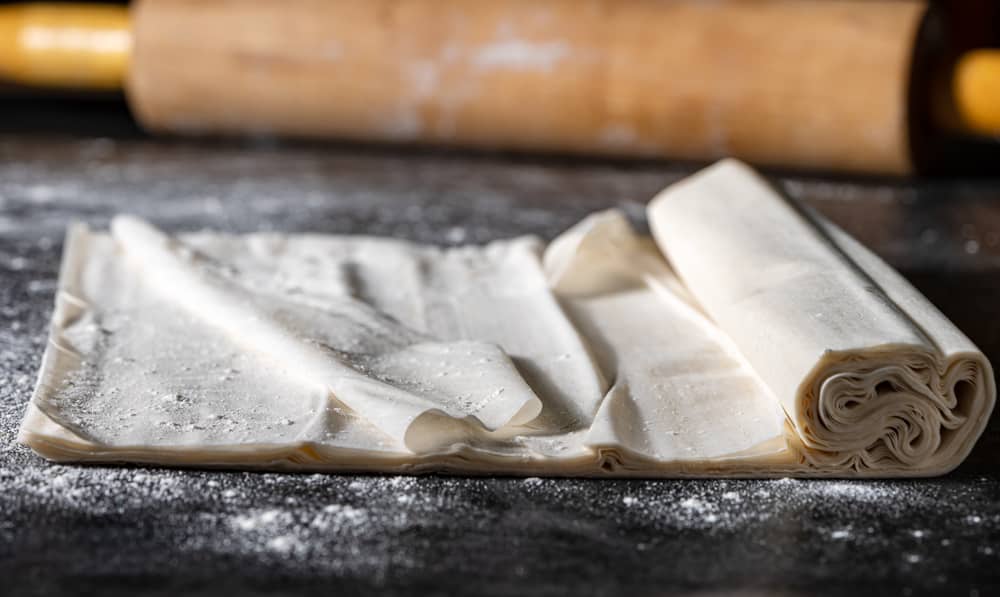
When it comes down to pies and desserts, there are so many types of dough to use. For this reason, many people compare strudel dough vs. phyllo dough. So, if you want to go ahead with baking with dough and are confused between the two, we are sharing the differences with you!
Strudel Dough vs Phyllo Dough
Strudel Dough
Strudel dough is defined as the layered pastry that’s made with the filling. In the majority of cases, the filling is sweet and it gained popularity back in the 18th century, especially in the Habsburg Empire. Strudel has become an important part of Austrian cuisine and it has become a part of Central European cuisines as well. In fact, Italy has recognized it as the PAT in South Tyrol (PAT is the agri-food product). The oldest recipes date back to 1696.
As far as the origination is concerned, the pastry descends from the eastern pastries, such as Turkish cuisines and baklava. As far as the dough is concerned, it is used to make apple strudel, which is filled with apple. In addition, there are topfenstrudel that’s made with soft quark cheese and millirahmstrudel that’s made with milk cream. Strudel dough is also made with sweet cherry, sour cherry, raisins, and nuts. In case you are wondering about the savory options, the dough is used to make strudel with cabbage, pumpkin, spinach, sauerkraut, and potatoes (some people add meat as well).
The strudel dough is made from high-gluten flour, salt, oil, and water (nope, there is no sugar). Given these ingredients, the dough has an elastic texture. The dough is worked through aggressively and it’s rested. Once the rest phase is done, it is rolled out and stretched in a thin form to make the pastry. As far as the thinning is concerned, it’s done with the help of kitchen paper and a linen tea towel. Some people also pull the dough manually.
For instance, some people roll the dough by pulling it apart with their hands. In fact, the dough is made too thin that you can even read out the newspaper. When the dough is thinned out, it’s laid on the tea towel and the filling is added on the top. As a result, the dough is rolled and baked to make the pastry. The inculcation of the ingredients needs to be accurate to ensure the dough is baked in a crispy form.
Phyllo Dough
Phyllo dough is the unleavened dough that’s made for making pastries. In the majority of cases, phyllo dough is used for making borek and baklava in the Balkan cuisines and Middle Eastern cuisines. The pastries are actually made by laying multiple filo sheets with the help of butter or oil. As a result, it is properly baked. Coming back to the dough, it is stretched into the paper-thin sheets but the origin is still unclear.
Many people say that phyllo dough is derived from the Greeks from 800 B.C. where the dough was sweetened with honey and walnuts. However, some people also add honey and milk to the dough to bake it later. On the other hand, some people say that phyllo dough was originated in Turkey and dates back to the 11th century. In case you are wondering about the ingredients, phyllo dough is made with minimal oil, water, and flour.
To be honest, making phyllo dough can be challenging and it will take time. This is because it requires stretching and rolling into a thin form. To knead and roll phyllo dough, a big marble top table is used. The dough is stretched with the help of hands but a long rolling pin is also used to ensure constant flouring. Moreover, the dough is constantly rolled to prevent sticking when you have to integrate the sheets. Currently, people are also using mechanical rollers to thin out the dough.
As far as the utilization is concerned, phyllo dough is used for making pastries and is rolled to gain the desired thickness. In addition, before the filling is added, the dough should be brushed with oil. Moreover, multiple layers are stacked together to make a thicker dough, which is rolled and folded to make laminated dough. All in all, the phyllo dough is used in rolled, folded, layered, and ruffled form